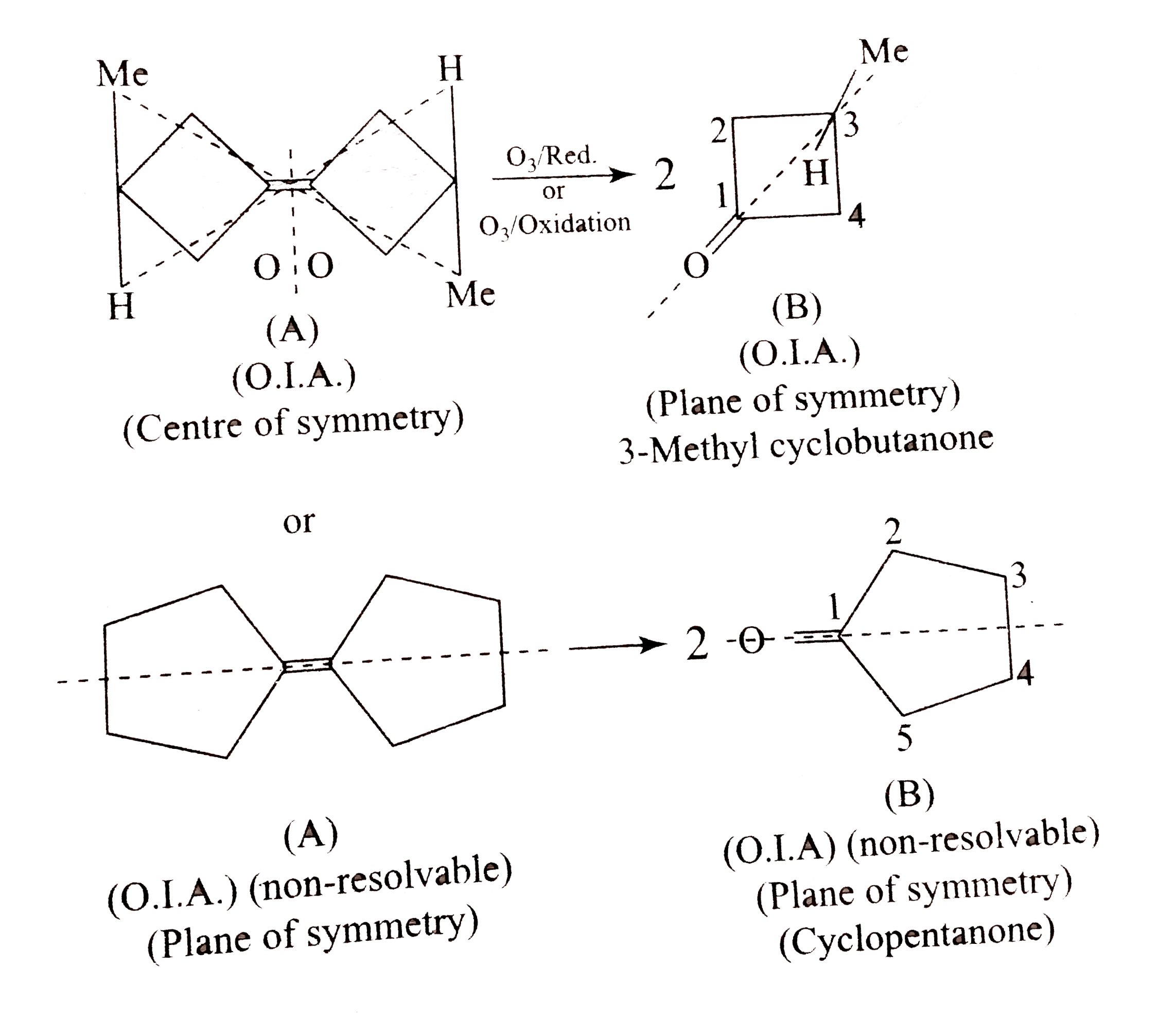(A)(C10H16)Reductiveoroxtive−−−−−−−−−−−→ozonolysis(B)(C5H8O)
(A) reacts with one equivalent of H2/Pd
a. Both (A) and (B) are resolvable.
b. Both (A) and (B) are irresolvable.
c. (B) is resolvable but (A) is not.
i. D.U. in (A)=(2nC+2)−nH2=3∘( one (C=C)+two rings )
ii. D.U.in (B)=2∘[one (>C=O) group and one ring ]
iii. Since (A) reacts with one equivalent of H2, one (C=C) and two rings of five C atoms or four C atoms with one (=Me) group in each ring.
iv. Moreover, oxidative and reductive oxonolyses give the same product, so (B) must be a cyclic ketone.
Possibilities are :[ alkene of the type  and (C=C) exocyclic to both rings. ].
and (C=C) exocyclic to both rings. ].
a. 
b. Both (A) and (B) are optically inactive( non− resolvable ).

c. (A) is non− resolvable but (B) is resolvable. ltbr> 
Topper's Solved these Questions
- ALKENES AND ALKADIENESBook:CENGAGE CHEMISTRYChapter:ALKENES AND ALKADIENESExercise:linked Comprehension Type
Explore 38 Videos
- ALKENES AND ALKADIENESBook:CENGAGE CHEMISTRYChapter:ALKENES AND ALKADIENESExercise:Multiple Correct Answer Type
Explore 41 Videos
- ALKENES AND ALKADIENESBook:CENGAGE CHEMISTRYChapter:ALKENES AND ALKADIENESExercise:SOLVED Example
Explore 62 Videos
- ALKANES AND CYCLOALKANESBook:CENGAGE CHEMISTRYChapter:ALKANES AND CYCLOALKANESExercise:Archives
Explore 13 Videos
- ALKYNESBook:CENGAGE CHEMISTRYChapter:ALKYNESExercise:Exercises (Archives - Analytical and Desriptive Type)
Explore 4 Videos
Similar Questions
(A)(C10H16)Reductiveozonolysis−−−−−−−−−−−→(B)(C5H8O)
Oxidationozonolysis−−−−−−−−−−−→(C)(C5H8O2)
(A) reacts with one equivalent of H2/Pd.
Give all the possible structures of (A),(B) , and (C) if all of them are non− resolvable.
View SolutionC11H16 (A) reacts with two equivalent of H2 and on reductive ozonolysis gives two equivalent formaldeyde and (B) of the following structure.

Identify structure of (A).
View Solution
Knowledge Check
Mg3N2H2O−−→A(gas)CuO−−→ΔB+C(g)+H2O,C(g) can be obtained by heating:
A(NH4)2SO4B(NH4)2Cr2O7CNH4NO3DNH4CICH3COOHP2O5−−→AC2H5OH−−−−−−−→pyridineB
Identify BAMethyl acetateBEthyl propionateCEthyl acetateDMethyl propionateEster A(C4H8O2)+CH3MgBr(2 parts)H3O+−−−→C4H10O(alcohol B)
Alcohol B reacts fastest with Lucas reagent. Hence, A and B respectively areACH3O∣∣COC2H5,(CH3)3COHBHO∣∣COC3H7,(CH3)2CHOHCCH3O∣∣COC2H5,(CH3)2CHOHDHO∣∣COC3H7,(CH3)3COH
C8H10(A)O3.H2O−−−−→ Acid (B) Identify (A) and (B) in the above reaction
View SolutionC8H10O3,H2O−−−−→C4H6O2 Acid (B), Identify (A) and (B) in the above reaction
View Solutionn−C7H16V2O5,500∘C−−−−−−−→10−20atm.ACl2,hv−−−→B
What is B in the above reaction?
View SolutionCH3−C≡C−CH3H2−−−−−−→Pd−BaSO4(A)D2−−→Ni(B)
Product (B) of above reaction is
View Solution(A)(C4H8O)H3O⊕−−−→(B)CrO3−−−−−→acetic acid(C)CH2N2−−−→Δ(D)
The compound 'D' is
View Solution

